|
|
| 'Like' us on Facebook | Follow us: |
Posted on: Mar 26, 2014
 |
A Radio Sai Exclusive Interview with Dr. K. Narasimhan, the Inspiring Chief of the
Sri Sathya Sai Mobile Hospital
When a disciple - in this case a highly qualified medical doctor - responds to His Master's call and surrenders totally to His will without reservation; when he applies himself day and night to the task assigned, consumed only by the passion to rise to the Master's expectations; the net outcome is the miracle called Sri Sathya Sai Mobile Hospital.
On 23 December 2013, the Sri Sathya Sai Mobile Hospital was recognised by the jury of CNBC-TV18 Health Care Awards, for its use of innovation to transform lives. Today Radio Sai is pleased to bring to you a special conversation between the Director of this project, Dr. Narasimhan (DN), and Radio Sai’s Karuna Munshi (KM). This was originally a live studio conversation featured on our Thursday Live show ‘Morning Glory’ on 2 January 2014. Reproduced below are edited excerpts of that inspiring interview.
KM: Sai Ram Dr. Narasimhan, and a very warm welcome to ‘Morning Glory.’
DN: Sai Ram Madam! I’m grateful to Bhagawan for allowing me to be a part of this project, and to Radio Sai for giving me this opportunity to share some of our team’s experiences and also talk about the events which took place on the 23 December at the Taj Palace Hotel, New
Delhi where the Sri Sathya Sai Mobile Hospital was presented the CNBC-TV18 Healthcare Award.
KM: And we’re really looking forward to all the details. Now let’s just go back to the moment when you received the news about the award, can you recreate that moment for us. Were you surprised?
 |
DN: Yes, normally as you all know we take seva as sadhana, a spiritual exercise meant for our own individual evolution. So honestly speaking, I wasn’t elated or exhilarated at that moment. But after a while I felt reasonably happy, because the award is more a form of recognition that will make people aware of the extraordinary medical services being provided even today by Bhagawan Sri Sathya Sai Baba’s institutions. This particular project was started by Bhagawan eight years ago, and it has stood the test of time. And all of Bhagawan’s institutions are not only doing well but are also expanding and diversifying, and have shown to the world that it is the teachings and principles of Baba which drives them, and not just His physical frame.
The Event at New Delhi
KM: Very well said doctor! Please tell us all more about this function at the Taj Palace Hotel in the national capital New Delhi, that you attended with Mr. Naganand?
DN: Before I talk about that, I would like to clear a small misconception.
A lot of hype has been created that Dr. Narasimhan has won the award. The truth is that, it is the Sri Sathya Sai Mobile Hospital that has been honoured. Bhagawan, in all His grace gave me the privilege to play an important role in this project, but still it is the Mobile Hospital that has got this highly prestigious award. Initially I didn’t know much about the award but when I went to that ceremony and heard the organisers describe as to how the winner is chosen, I was really dumbfounded.
KM: So did somebody nominate us? How did it happen?
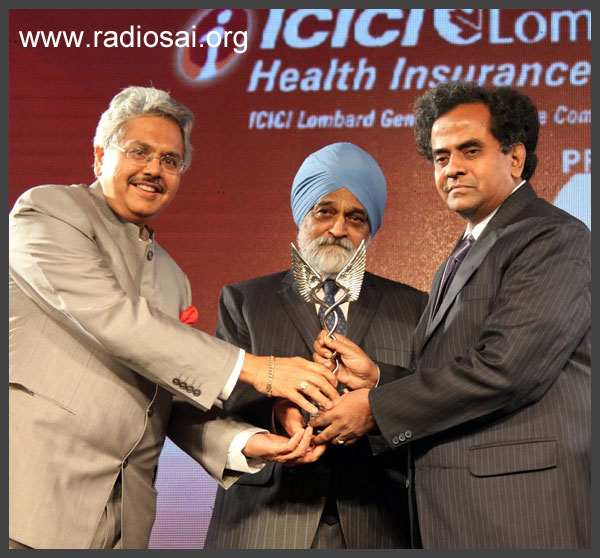 |
|
| Mr. Naganand and Dr. Narasimhan receiving the award from Dr. Montek Singh Ahluwalia, Deputy Chairman, Planning Commission of India, 23 Dec 2013 |
DN: No. The CNBC group and the ICICI group outsource the work of screening and shortlisting over three thousand hospitals to the Indian Medical Research Bureau. (IMRB) and as a part of this agreement, the IMRB ensures that there is no external influence during the screening process. So it’s amazing - the IMRB actually visits all these hospitals over the span of a year in a very discreet and confidential way. None of the hospitals know of these visits, nor do they know about who shall be visiting. In fact we did try to ask the jury as to who it was that came to us for screening, but they were reluctant to disclose it. This makes it even more special because as you know, in the Sri Sathya Sai Organisation we do not make any overt or subtle claims about our pattern of working.
KM: True! We are traditionally publicity-averse because our actions speak loud enough. When you were at this function what sort of a reaction did you sense from the gathering there? It was the Who’s Who from the Indian healthcare industry and most of them represented private hospitals. Now, you were just two gentlemen representing the Sri Sathya Sai Health Care System. What was everyone’s reaction like?
DN: Our Dr. Mohan from Chennai, the internationally renowned Diabetologist, and the Chairman of the Sathya Sai State Trust of Tamil Nadu was there (incidentally, his Diabetes Specialities Centre in Chennai was also one of the winners in the Single Speciality Hospital Category). He told me that when we went to take the award, there was a thunderous applause. It was almost as if all the people felt that doing such a service for free was a very noble thing. Even though these corporate hospitals are themselves profit driven, I think, in the heart of hearts these people (who were from such hospitals) knew that it is good to provide good healthcare free of cost to the needy patients. In fact, even before I came to Prasanthi Nilayam, when I was a part of a team in Hyderabad that did free service in the villages, whenever I would make a call to any of the leading surgeons, for a patient that needs treatment, they would never say no. They were only looking for an Organisation which is transparent in its motive, pure in its conduct and really helping poor people.
So on that day in the hall, the other hospitals and the other award winners must have been surprised, and at the same time felt happy deep within. During dinner many people expressed their appreciation for Bhagawan Baba and His organisation. More so because, in our conversation we kept reiterating that it is He who started it, it is He who runs it and that we still feel His presence every single day.
A True Example of Innovation to Bring Transformation
KM: Good to know that they were generally so open minded about this. That’s beautiful! Now, I understand Mr. Naganand gave an acceptance speech. What was the gist of it?
DN: The gist of his speech was mainly that these institutions were started by Baba and that they don't charge even a penny from the beneficiaries. He talked about the various types of hospitals which are running under the Sathya Sai Central Trust. But to tell you frankly I would’ve liked to say a few words especially about CNBC's criteria for recognising us – that is the two words they used - 'Innovation' to bring 'transformation' in lives. This according to me is an apt description of the work we do.
 |
| Mr. Naganand, Member, Sri Sathya Sai Central Trust, delivering the acceptance speech at the event |
The innovation and the transformation has been going on at three different planes the physical, the mental and the spiritual. This is very much in line with the World Health Organisation's revised vision that health is not just the absence of disease but a state of complete physical, mental and spiritual well-being. You must’ve noticed that, they have added the spiritual dimension of health. Bhagawan defined health as a state where five components are present, they are ‘Aahaara’, ‘Aachaara’ ‘Vichaara’ ‘Vihaara’ and ‘Uchaara’.
‘Aahaara’ relates to the food that we partake. Even as per the early Indian philosophy, they say that the most subtle part of the food becomes the thought. ‘Aachaara’ is one’s conduct, be it in the community, at the work place or in the family. Then, ‘Vihaara’ refers to the places that one visits, like a satsang or a club. ‘Vichaara’ is the most important one, (which even Swami always emphasised) the thoughts that one entertains. And finally, ‘Uchaara’ means the words one speaks. Thanks to Bhagawan's divine vision and guidance, from the beginning the mobile hospital has been taking this definition as the guiding principle for planning its activities.
Now, when we talk about how this project was initiated and how it is being delivered, it is all really a miracle of Bhagawan himself. He started it in 2006, and at the time the rural healthcare delivery system in India was literally in shambles. It was tricky, so to speak. The Government was contending that it was not possible to take technology in the form of these high-tech equipments like CT scanners and MRI machines to villages, and install, run, maintain, and service them as per requirements.
The second side of the tricky triangle was the reluctance of the doctors to go to rural areas. They said that there was no infrastructure available to match their qualifications and their professional reputations. They also said that it was not possible for them to adequately educate their children in those rural places. And the base of this tricky triangle was that the villagers were not able to access even the small facilities which were available in the towns. This was because of various reasons like the fact that they lived on daily wages, old people had nobody to take them, the general ignorance about health and disease, etc. So in these circumstances, the Master decided to take over. Swami made a very simple point, He said that there was no need to install all the machines in villages, instead we should carry them in mobile vehicles, and take the doctors in such vehicles. He told us to create makeshift hubs at the village school which would serve as a mini-hospital. Provide the services here from morning to evening, so by evening, the doctors could come back to the city and also the servicing and maintenance of the machinery can be done.
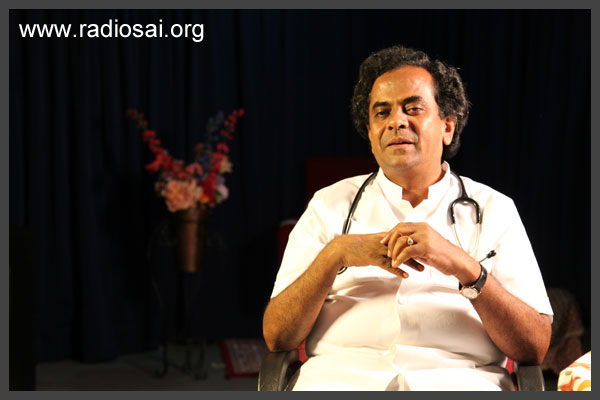 |
|
| Dr. Narasimhan at the studios of Radio Sai |
This apparently simple but highly innovative solution has revolutionised the concept of rural healthcare delivery in India. Our country’s Principal Scientific Advisor, Dr. R. Chidambaram had come to see our project and he was with us for two hours, and the next day he was asked to speak in Swami’s University on the topic - ‘Innovation’. During the talk he said that on the previous day he had witnessed the best innovation being made by Baba, where a school is converted into a hospital and the most complicated services are rendered there, and at the end of the day the hospital becomes a school again. He said that he couldn’t think of a better example for innovation.
KM: And this comes from Dr. Chidambaram the Principal Scientific advisor to the Prime Minister and Government of India!
While going through the pictures of this function that you were at, I noticed that the Deputy Chairman of the Planning Commission of India, Dr. Montek Singh Ahluwalia was also in attendance. Did you get an opportunity to interact with him?
DN: He was on the stage for most of the time and it was on the stage itself that he asked me if we had similar institutions all over the country or if we were confined only to Puttaparthi and Bangalore? I told him that under the Sri Sathya Sai Central Trust we didn’t, but I did tell him about the Sri Sathya Sai Seva Organisation, which also was started and blessed by Bhagawan Himself and the spirit of the whole exercise is also imbibed by them, and that the Seva organisation through its various samithis is doing a good number of activities in the same spirit, but the quantum or the calibre of those activities wasn’t at the level of the mobile hospital or super speciality hospitals.
KM: And did you impress upon him that these projects were prototypes? That these were case studies that Bhagawan had set up?
DN: Yes. Not only to him but also to the other eminent doctors, like Dr. Trehan and Dr. Ajit Panda, the eminent cardiologists who were also there. I told them that Bhagawan had said on a number of occasions that He has not come to solve the medical problems or the other social problems. That He believed in setting models and these models can be replicated by any other government or private Organisation. In terms of quantum, Swami never wanted a super speciality hospital in every city. He believed that even for individuals, these institutions would act as an outlet to do their daily seva or daily sadhana for their own evolution. But for the government and other non-governmental Organisations this serves as a model.
The Birth and Genesis of the 'Moving Miracle'
KM: Now for the sake of our listeners, can you please go down memory lane and tell us a little bit about the start of this wonderful project, the Sri Sathya Sai Mobile Hospital. The facts and figures involved are so mind boggling and almost hard to believe.
DN: The genesis of this project was way back in 2005, I think in the month of March. Bhagawan just called Mr. Chakravarthi and asked him whether we can have a bus in which we can have a scanning machine, a lab, an ECG machine and other such equipment.
KM: Out of the blue?
DN: Yes. So Mr. Chakravarthi perhaps told Swami that it may not be readily available off the shelf, but one could get it fabricated on order. But Swami again asked him to check on the internet, and when he did, to his surprise he found that Siemens India was already on the job and they had delivered two such buses in the state of Uttaranchal to a non-governmental organisation. So when he got back to Swami with this information, things started moving forward, and with Bhagawan you know, they go at a very rapid pace.
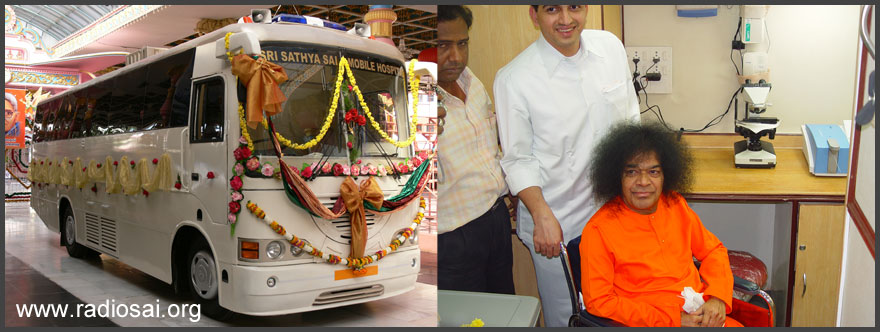 |
| The Mobile Hospital bus on the day of its commissioning. (Right) Bhagawan inside the bus, inspecting it and infusing it with His love and blessings |
One interesting thing which I would mention is, normally when Swami executes a project, He assembles all the three Ms - the Man-power, Material and Money (or resources) so that the work just begins in the way that it is thought of. But in this project, Swami was not talking at all about the manpower part. Mr. Rajiv Mahajan, who is more than a brother to me, is one who has played a pivotal role in not only getting the bus but also its subsequent maintenance and other such aspects. He along with Mr. Chakravarthi and other administrators asked Swami two or three times, as to how they were to run the project as no recruitments had been made up to that point. In response Swami said, I will give you a good doctor. They were emboldened enough to then ask Swami, “Swami what will one doctor do?” then He said, “I will give good doctors too.” The day Bhagawan called me and asked me to take over the mobile hospital, I said yes.
KM: What were you doing at that time sir?
DN: I was co-ordinating the Mother and Child program of the Easwaramma Women’s Welfare Trust.
Then Mr. Chakravarthi asked me as to what gave me the courage to say yes. I told him that there were two things, first off – all Sai devotees understand that when Swami makes a sankalpa it has to happen. Secondly, during my eight years in Hyderabad, I had done extensive Grama seva, i.e. village service, not just medical, but one which covered all aspects. During that time we had a good team of 150 doctors.
A Mobile Hospital and Not a Mobile Clinic
Through my experience I learnt that it is service which attracts people to come and join in. Instead of just starting off by recruiting twenty to thirty doctors, one needs to begin with two or three really good doctors. As time progresses, people realise that this service is transparent and has a pure motive, and using Bhagawan’s name only enhances its credibility. So as a result of all this, people tend to rally around you and there is a greater buy-in by likeminded professionals. Most rural medical programs elsewhere are just weekend excursions where people go for just a day and give a Crocin or a B complex tablet and come back. But this project is different. Swami was very clear when He told me that He was naming this project the Sri Sathya Sai Mobile Hospital, and not a clinic or a camp. He told us that other than surgeries which require general anesthaesia, we should be able to do everything. And if we couldn’t do them at that time, we were to get them done. This was the message which Bhagawan gave us. I thought about this deeply and came up with five points, which I have always believed to be my lucky number because it represents Bhagawan’s Abhayahasta. The first one was 'Consistency'; because I wanted that we have a regular schedule. So we started drawing up a schedule for two weeks. It wasn’t possible to plan beyond that because the activity of a mobile hospital is very complicated and beyond two weeks the area of operation becomes very large, so a lot of time is lost in transportation.
 |
Dr. Narasimhan tirelessly and passionately serving the cause of rural healthcare Photo Courtesy: Tim & Trev |
The second was 'Skilled Manpower', because the credibility of our project or service would grow only when eminent people join the team. Even Swami said and I quote, “Vaidya Nipunalanu teesukellaali”, which means, take experts not just general physicians. Thirdly, I wanted that we have a proper 'On-site Diagnostic Support System', for which Bhagawan had already given His consent. It included facilities like ultra sound, x-ray and a lab; all this put together would cost about a crore Indian rupees.
Fourthly I thought we needed a 'Well-stocked Pharmacy', because one may have the best experts who do advanced tests and give the most accurate diagnosis, but at the end of the day if you give the villager a prescription he’s not going to do anything about it. So we came up with a method where we started giving medicines for a month to patients with diabetes, hypertension, epilepsy, thyroid, and all such chronic ailments. This is one subset of illness in the population that requires constant and continuous help. And Swami’s motherly help is always there. So we started giving these patients one month’s medication. Initially, many eye brows were raised and the administrators were also worried, but then it has stood the test of time. So we’ve continued with it.
 |
Every month a public school silently metamorphoses into a multi-speciality medical centre in rural Andhra Pradesh. Photo Courtesy: Tim & Trev |
The Divine Triangle Approach
DN: The fifth and final requirement was that the service should be the 'Holistic approach', which is so essential that even Swami mentioned it. It wouldn’t have been enough if we only provide a good curative service. So we thought of having a triangular approach, we decided to convert this tricky triangle into a Divine Triangle. The first limb of this triangle represents Curative Service, which is fundamental because unless we cure or help people from illness they would not be ready to listen to anything else that we’d say.
The next limb of the triangle is the 'Preventive Service', so each limb of this triangle supports and supplements the other.
KM: So you were educating them about health?
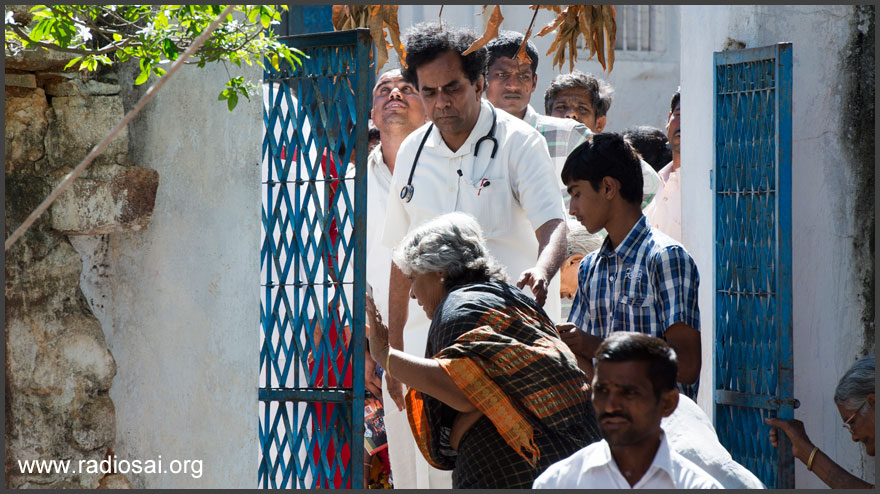 |
Photo Courtesy: Tim & Trev |
DN: Absolutely! We realised that we are entering into the community to serve, and that we are not like a static hospital. It is not enough if you mechanically enter, you need to penetrate into the community. So providing education about health in a way that brings a definite improvement in the general awareness of the people, became an important component of the mobile hospital. It is something that we all take very seriously. Every morning, I go to the village at 7 o’clock because more than three hundred patients usually are waiting, and I can complete the exercise of health education before the other doctors come. There were questions that were raised as to whether this practice of educating was having any effect at all, but in one interview with Swami, I had told Him, “Swami health education baaga chesthunnaamu kaani…” (Swami we are providing health education but…) in response to which He said, “No but …you have to do, you have to do, you have to do. It is your sadhana. It does take time to change their habits and practices.”
So we try to educate them on health issues like diabetes control and managing their blood pressure. But we try to do it using different tools and at different levels, through a lot of innovation. The morning speech is very formal and direct, the people who come are patients, we are the doctors; but in the evening, the talk is more humorous and interactive. I think that those who come to see it would really appreciate it.
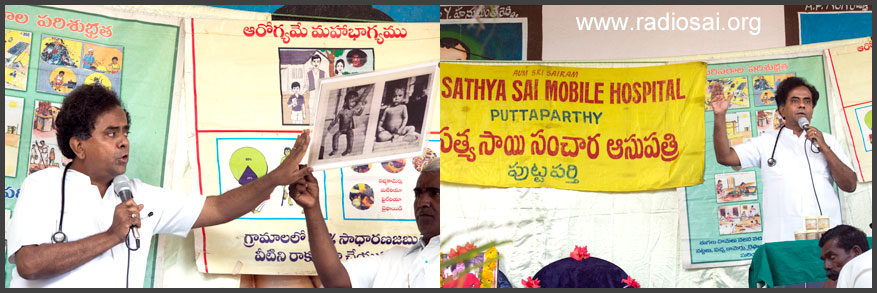 |
Dr. Narasimhan imparting health education in the villages, in a manner that the village folk can relate to Photo Courtesy: Tim & Trev |
Now we come to the final limb of this Divine Triangle, the 'Spiritual Base'. Swami has always talked about spirituality as something which is much higher than any religiosity or orthodoxy. We tell the patients that spirituality only pertains to positive thoughts, and adherence to the five cardinal human values that Swami has laid emphasis on. We tell them that prayer and meditation are not to appease God, but for one’s own health. We also try to add visuals to this process by showing them a video or two of Bhakta Prahlada or Bhakta Tukaram…
KM: Something which they can relate to…
DN: Yes, just 15 to 20 minutes of edited video and then we try to encourage the habit of namasmarana writing. You will be surprised to know that we have around ten thousand likhita nama japa books completed by the patients.
In fact, once I told Swami, “Swami we should build a Likhita japa mandir.” Hearing this He was immensely pleased and He patted me. I said this because in Rishikesh in Sivananda Ashram I have seen mandirs where only likhita japa is done by devotees.
So with this triangular ideology, I feel that the words which they (CNBC-TV18) have used, 'innovation and transformation' really apply beautifully to this initiative. That is why we were thrilled. Because even though we do this as sadhaks who take seva as a sadhana, and aren’t really generally concerned about rewards and recognition, what this award has done is that it has made people aware about the stellar role that the Sathya Sai Institutions are playing and also about the beautiful ideology of the mobile hospital.
An Ideology to Remember Every Moment
I remember when I went to Swami with an album in which we had described this concept of the Divine Triangle, the limbs of which we named as, Curative Drive, Preventive Focus and Spiritual Base, Swami saw this and started patting me on my back, and He continued to do this. I was so thrilled that moment, but then Swami came close and said to me in my ear, “Prati kshanamu ide bhaavamutho pani cheyali”, which means “Every second you have to work with this ideology”. Most NGOs have a mission statement or background or underlying ideology, but Swami did not give us any. He said, ‘prati kshanamu’ (every second) one has to work with this concept (Divine Triangle) in the heart. That was something which really hit me, and it made me realise that we must maintain that mind-frame throughout. So we begin each day's activity with a prayer to Bhagawan, that He reminds us again and again of these three aspects of health care delivery.
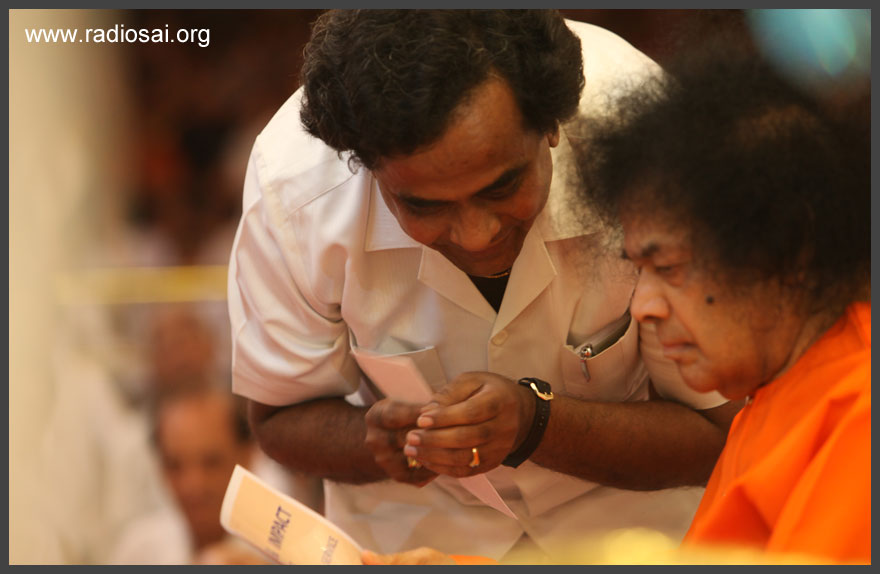 |
A Well Thought-out Schedule
KM: You talked about having a fixed schedule, so as to have a good degree of certainty in the activities; what are the days that the mobile hospital operates?
DN: The 1st to 12th of every month has been fixed for curative services and the last day of every month is for preventive service. So we’ve tried to do away with any kind of randomness. What we did is that we took a radius of 50 kilometres around Puttaparthi, which was the upper limit because the diagnostic bus moves very slowly. This area comprised of six mandals (wards) which we further sub-divided into what we call nodal points. This nodal point is a village which we use as a base, because it is the centre point of about 40 to 50 villages surrounding it. We have fixed dates for visiting each nodal point, so on that particular date of every month we visit the same village. For example, on the 2nd of every month we visit a village called Byrapuram and this being a nodal point 600 to 700 patients are attended to. The devotees that I have interacted with, especially those who come from overseas find it mind boggling that we, with our team of
15 doctors, of nine different specialities are able to cater to such a vast audience. Also, we have chosen these nodal points in a way that they make a circle on the map. This we thought would be like a garland around our Master.
This pattern is practical too, because if one puts ten points on a circle, for every point there are two points that are quite close to it. What this does is that it allows us to do periodic reviews on patients who require it, like for a patient who’s suffering from hypertension or diabetes we need to do a review after a week to check whether the dose is sufficient or lacking. So you see a lot of thinking has gone into each aspect of the logistics.
Swami as you know gives us broad guidelines which we strive to follow. Once in an interview, where it was just Swami and I, after He blessed me with a chain, I said to Him, ‘Swami, Shraddha to, bhakti to pani cheyali”, and just as I was about to say “prema to”, Swami said, “Prema to” (with love)..
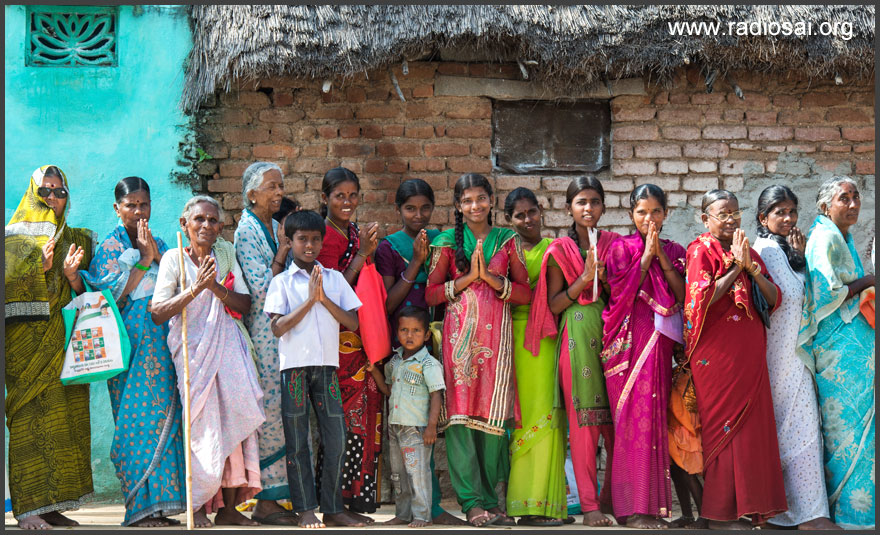 |
Photo Courtesy: Tim & Trev |
I said, “Swami please bless me with devotion, dedication, humility…” and Swami promptly added, ‘Prema to’ which means with love, and then He told me that 60% of the treatment is rendered by the love with which you doctors and paramedics offer treatment. He said that it is only the remaining 40% where, if the doctor does a good job, Swami's grace will flow. So at our small monthly meeting with the team, I always tell them that even if we are not able to do much else we must do our duty of looking at, talking to and taking care of the patients with love. At no point should we be harsh with them for any reason.
Building and Strengthening the Model
KM: This redefines the very concept of patient care, it is as though the patient is God Himself. Now, where do you get these doctors from? Who are they and what are the specialities they represent?
DN: As I told you earlier, I had a good team of 150 doctors before, most of them had never seen Bhagawan and were not devotees in the general sense of the word, but they were people who were attracted to the idea of service. And with all sincerity I can tell you madam, and I don’t just say this because I am a doctor, but every doctor has this genuine urge or an instinct within to give back through selfless service, to that society that has nourished and nurtured him or her. If only we can provide a mechanism through which he or she can convert that sense of responsibility into a noble activity, they will definitely come forward. And that’s how about 150 doctors were a part of that team.
| A Short Documentary - Sri Sathya Sai Mobile Hospital, Advanced Medicare at the Doorstep of the Needy |
Once a few doctors started coming, we tried to expand that number by using, I would say, a few tricks! I would tell them, “When you go on a tour or vacation you generally take along a few friends or relatives isn't it? Why don't you bring along some of them, especially those who are doctors... they can enjoy the ashram ambience.” That way we drew more people. Then I wrote a letter to all the District Presidents of the Sri Sathya Sai Seva Organisation asking them to send a list of few more doctors. So our strength got bolstered even further. When I look at the way the Sri Sathya Sai Mobile Hospital has progressed, I can see three distinct phases. The first phase was the setting up of the whole thing, the framework that we built. The second step was streamlining the work in a way that each worker got to do what he or she was good at and enjoyed doing. This stage was all about allocating work and stabilising its flow. It was about putting a system in place so that it did not depend on me or any one person. For example, when I went on leave when my mother passed away, even in my absence, the regular working of the hospital didn’t stop or lag behind in any way. So having a well-defined system really helps.
And the third and final phase was all about diversification; which is where we try to improve the depth of the service. We don’t want to increase the width of the service because as I said earlier, it is not possible for us to go beyond 50 kms radius for logistical reasons. So when I say that we are trying to improve the quality I’m talking about the introduction of new gadgets like EEG (Electroencephalography), Colour Doppler machine, and a new machine for doing hearing tests, and other such diagnostic facilities.
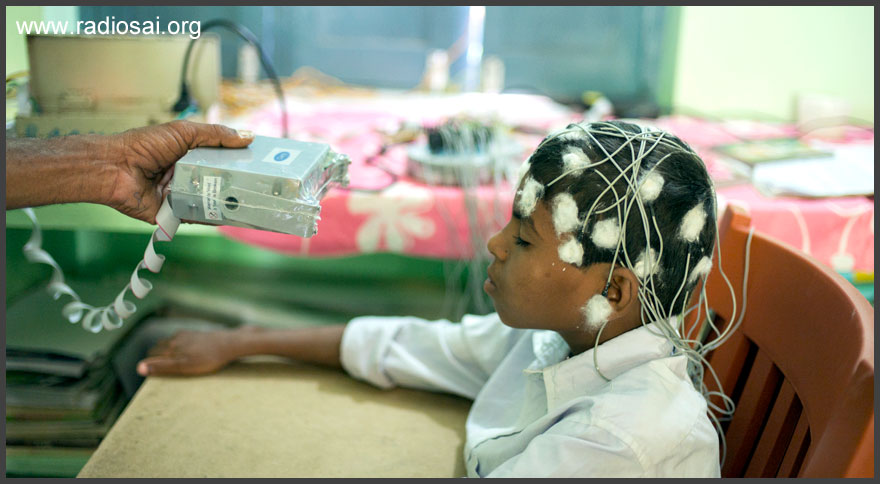 |
Electroencephalography test in progress Photo Courtesy: Tim & Trev |
Offering Further Treatment Where Needed
KM: If you have patients who require further specialised care, what do you do for their referral?
DN: That’s a wonderful question. In fact, I think that is the benchmark of any outreach service, the extent to which complex problems can be catered to. In this context, one can broadly bifurcate the ailments into six types, common, chronic, asymptomatic, preventable ones, intractable ones, (these require a higher degree of care like one might need a surgery) and finally emergency problems. Although we can never handle all types of emergency problems, there are a few that we can, like a scorpion sting or a snake bite, etc. However, unless an outreach service is able to take care of the other four or five it’s not worth its name, in my opinion. And that is exactly what I say to our friends in Mumbai or in any other city. That, by having a regular ambulance facility which doesn’t cater to even the common ailments is like missing even the tip of the iceberg, the iceberg being all the six types of ailments.
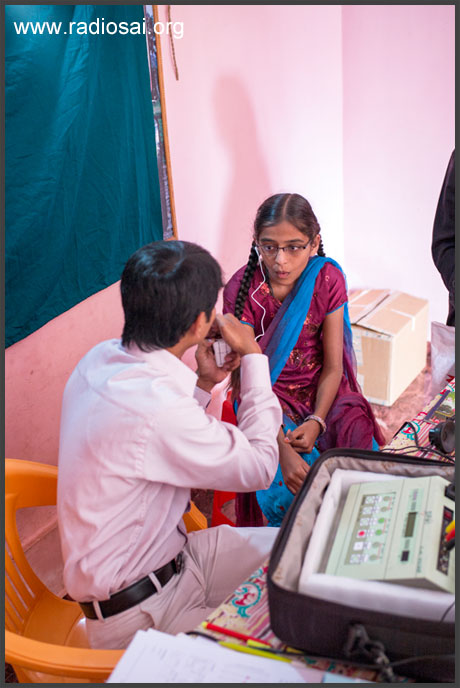 |
|
Photo Courtesy: Tim & Trev |
So while dealing with the ailments which require further care, after identifying the patient we do all the necessary tests, especially if it is a surgical case, we do what is called a surgical profile, that is; how is his heart? How are the lungs? Is the blood pressure alright? Is he physically fit to undergo the surgery? Is he going to improve after the surgery? All of this, we do on the field itself. From the 1st to 5th of every month the General Hospital gives its theatre and its nursing staff to us. I am happy to tell you we have started doing laparoscopic surgery in the mobile hospital, and today we performed the first surgery.
KM: Wow, congratulations!
DN: Thank you! That's a pleasant coincidence! And today being Thursday also makes it very holy for us! So at the Sri Sathya Sai General Hospital, here in Prasanthi Nilayam, we do general surgeries, ENT and gynaecological surgeries. All this is not to show people what all we could do, but we do want to prove that an outreach service even if it is of the nature of a mobile hospital, should be able to handle things which has to be done back home. It need not be quantitatively up to the mark, because the volume of cases which we have is three or four times our capacity but what is important is that we create a mechanism to provide that service. In fact, we have been successful in carrying out cancer surgeries; one beneficiary of which is a staff member of Swami’s College, Anantapur Campus. She had breast cancer, and we operated on her. However there are certain surgeries which we cannot do, in those cases we do what is called a facilitatory service in which we do the diagnosis and the tests, we give the slide and the block if it is a cancer case, and then we refer them to the referral hospital.
For cancer cases, we have an onco-surgeon, Dr. Rajagopal who comes from the Indo-American Cancer Centre at Hyderabad. He comes frequently with the mobile hospital, and he looks after the cancer patients we send. Now, once the surgery is done, and the treatment is over, these patients come back to us; so that the loop is always maintained. We want do seva, and not just do something and wash our hands off.
Infinitely Inspired and Inspiring
KM: And the sincerity of this effort comes through loud and clear Dr. Narasimhan. Actually I just want to deviate a bit and I want to ask you – your motivation is so high, your vision is huge, your leadership qualities are obviously unparalleled and you are unbelievably dedicated to what you do, what did you grow up on? You must have tremendous motivation to be doing what you do every single day, there is no repeat-action-injury, instead there is repeat-action-inspiration here. Who is the power behind all this? You must have a very supportive wife and family.
DN: Yes, that's true, I have a very supportive family. When I left my previous job, from where I used to receive a very comfortable salary, my father was a little apprehensive at first because he came from very humble beginnings. On Shivaratri day Swami called me and gave me a Ganesha vigraha (idol) and told me that he will take care of everything. When I went back home and told my father about this, he was convinced and never worried about me after that. Even my wife is very supportive and I would say to her, just as it is preached in Indian culture, the Dharma Patni (wife) must support the husband…
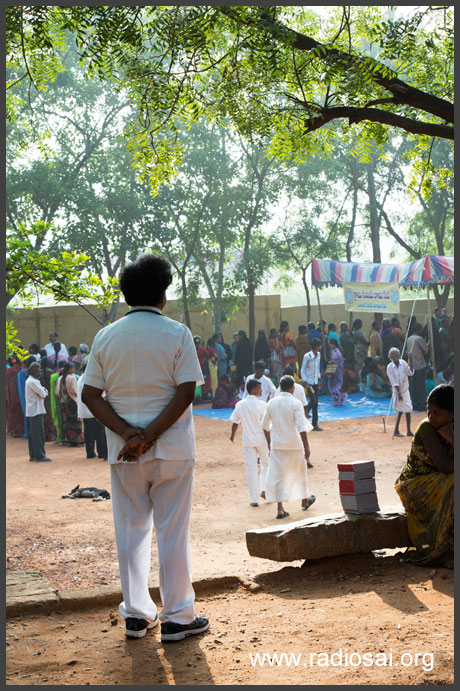 |
|
Sometimes it is thrilling to step back and marvel at what God can do through us Photo Courtesy: Tim & Trev |
KM: Preferably, when he is walking on the path of Dharma!
DN: That is correct! I also told my wife that we must listen to Swami, and that it’s very possible that if we don’t listen to Him, our lives and our children’s lives may go haywire. But believe me, at the time I began none of my family members were devotees of Bhagawan as we understand. We never knew Baba. As a doctor, I was more attracted to the idea of service. And I would like to go on record and with humility pay profound gratitude to Mr. Rommel. He has been my inspiration and guide on the physical plane while on the divine plane it was Bhagawan. Mr Rommel showed me that it is not just in words or in books that one can find individuals whose ethics and character towers over others, that it is possible to have your hands in the society and your head in the forest. I saw him working in the Hyderabad passport office and I was literally floored by his example. I think that this is why Bhagawan says, “It is your lives that have to be My message”. So whenever I’m in a tricky situation or even in the routine, I always go back to Him for His guidance. Though now he has stopped giving me overt advice because a while ago, Swami said to me, “Manasuki edi tochindo adi cheyi” (Whatever you feel like, you do). So he says, “Swami has given you a blanket cheque, you can do anything now!”
Still, I would like to stress on the fact that I have no words to express my gratitude to this gentleman, Mr Rommel. I have observed him very closely. This reminds me of
Mahatma Gandhi’s words, he said that in the bigger aspects of life everybody is magnanimous, but one should try to be magnanimous in the smaller things of life as well.
A Comprehensive Health Care Offering
KM: Going back to the mobile hospital, we notice that whenever the big mobile hospital goes out of the Gopuram gate it is followed by a whole lot of trucks carrying food. Would you like to tell us about that?
DN: Yes. Surprisingly, most people think that the bus is the mobile hospital. But, the bus only represents the diagnostic limb of the mobile hospital; it isn’t the mobile hospital by itself.
The Mobile Hospital includes the bus, but we also have a transport vehicle in which the diagnostics pertaining to each department are carried, like in the case of the department of ophthalmology, we have a slit lamp, an auto refractometer, a tonometer, etc. So the mobile hospital has diagnostics pertaining to what we call imageology, that is x-ray, ultrasound and pathology or haematology the blood tests.
We stop the bus a little away from the main mobile hospital which is lodged at a village school. There are five divisions, namely medicine, surgery, obstetrics and gynaecology, paediatrics, dentistry and ophthalmology. We also have five sections to regulate the patient flow. They are the reception section where the people come, the waiting section from where about 15 or 20 are brought in, then the doctors section, the diagnostic section for which we use the bus and fifth is the pharmacy.
KM: Sounds so well thought out! So what is the total number of disciplines or specialities, medical specialities?
DN: We have nine specialities on any particular day, and as a doctor with experience in public health I can tell you that these nine specialities are enough to cover most of the ailments prevalent in the society. But still, there are two more specialities which are still missing, psychiatry and dermatology. Now, the whole of Ananthapur district has only two or three qualified psychiatrists, fortunately, one of them who is the Head of the Department at the Government Hospital at Anantapur comes on the first Sunday of every month. He drives down all the way from Ananthapur to a particular nodal point, and we send all the psychiatry patients to that nodal point where he attends to 100 to 120 patients in one visit. Again in dermatology we have the same issue, but here we have a dermatologist who comes for four days every month. But basic dermatology can be handled by physicians like me also.
Now coming to the nine specialities, we have Radiology, which is really important, so we have installed a 2D echo ultrasound machine and an x-ray machine in the bus. Second is medicine, wherein we have doctors who have not just completed an MBBS but also an MD in General Medicine, the third is General Surgery, fourth Orthopaedics, fifth ENT, the sixth is Obstetrics and Gynaecology, seventh is paediatrics, eighth dentistry and ninth ophthalmology.
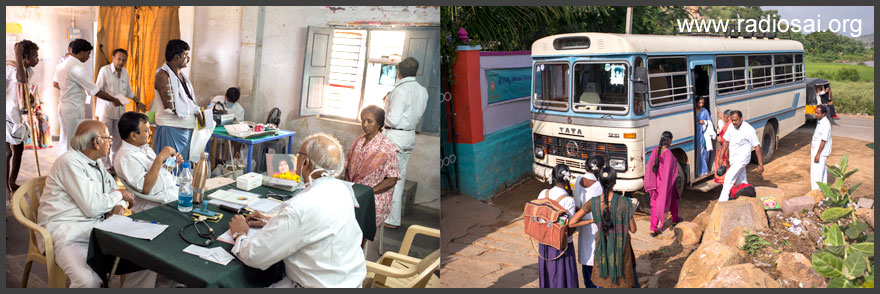 |
Photo Courtesy: Tim & Trev |
KM: Sounds like a dream team you have over there.
DN: Yes, in fact in one of the annual reports of the Central Trust, in the section about the mobile hospital, they had published a comment made by one Dr. MBR Sharma, who incidentally is in seva today. He was the Director of Medical Education which is the highest post for a doctor in the Government machinery. Not only that, he is a very eminent professor of medicine and is called ‘Ajaatashatru’ (unparalleled) in the coastal area of Andhra Pradesh. He joins us once in three or four months, and he said, “I have been in Government so many years, it is inconceivable to think of an outreach service with so many facilities”. We have an EEG (Electroencephalography) facility also, which is used to measure the electrical currents in the brain. We did this because we felt that it was highly inconvenient for the patients with say an epilepsy problem or a neuro problem, to go all the way to Bangalore just to get an EEG done. If we put ourselves in their shoes, we can understand how really tough it is for them; to go with a health problem to a new city seeking treatment. We have the resources, the contacts of people and it is easy for us but, what about these villagers?
KM: Never mind being a villager, even if educated people go to a new city looking for a hospital, quite a few of them will be so lost. And the experience is even worse when your pocket is empty and you can’t read or write.
 |
` |
Silently redefining patient care.. Photo Courtesy: Tim & Trev |
DN: I have worked in a corporate hospital in Hyderabad and I can tell you that it is not possible to meet so many specialists in one day, but here it is just across the room. If a physician feels that a particular case of abdominal pain needs surgical consultation he goes himself to the surgeon. Then if the patient is a lady the Gynaecologist enters the discussion, and then if they require a scan the radiologist enters. So many specialists working under one roof makes it an integrated multi-speciality facility.
The efforts have been co-ordinated in a way that the patient doesn’t have to do any running around, because Swami was very particular about this, “Meeru patientlanu tippavaddu”, “Don’t make them run here and there”.
KM: So considerate...
DN: Yes, and we’ve tried to adhere to Swami’s guidelines in every aspect. For example, some patients require blood tests which cannot be done on the bus. Now, we do not ask them to go to the Super Speciality Hospital, even though the Super Speciality insists that the patients come. I spoke to them about this and convinced them that we will centrifuge the blood, take the serum in ice cold packs in sets of thirty, instead of 30 people specially making the visit and one of our volunteers can go and bring the reports. So you see these are the small innovations that we have made on every front, keeping the patients' comfort in mind.
As I sit here in front of Swami I can sincerely say that every single thing which is in the mobile hospital has come about after deliberate planning keeping the patient in mind, as though he or she is our father or mother. Sometimes this may not be possible, because these are idealistic things but this thought and feeling is prevalent, and that is the guiding spirit. One may not be successful all the time in something like this, but when you genuinely harbour this thought in your heart one day or the other it will become the way of the working of all the institutions.
KM: And I hope that the day comes soon. The whole team sounds like a team of angel doctors. I wish all medical practitioners could learn from you all. So much good is coming out of this exercise. Why is it that the government and the other NGOs are not biting this bait and following it? It’s a beautifully thought out, considerate and loving model which has the best of the professional and the best of spiritual component infused in it. Is it because this wouldn’t translate into votes? Is that what’s holding them back? Those are big budgets which the government has for the primary health and rural development sector. And most NGOs talk so much, usually hunting to make headline news, but Swami never cared for awards or recognition, and silently a revolution has been taking place.
DN: Like I told you, perhaps the senior most man in the technical field who’s in the Government, Dr. Chidambaram, he wanted us to give him a write up on all of this. At that time Mr. SV Giri (Central Trust member and former Vice Chancellor, SSSIHL) was taking a lot of interest in the mobile hospital and sent him the requisite notes and a CD about all this, but what we quickly learnt is that it is not the technical men in India who carry the power, it is the bureaucrats. We did send them a write up but nothing has come out of it, Perhaps we as an organisation are not proactive enough, may be they should come and see it themselves.
And when we talk about NGOs, though most of them have really good motives but one can’t compare that with the love that Swami gives us, even now we all just can’t find the words when we talk about Swami’s love.
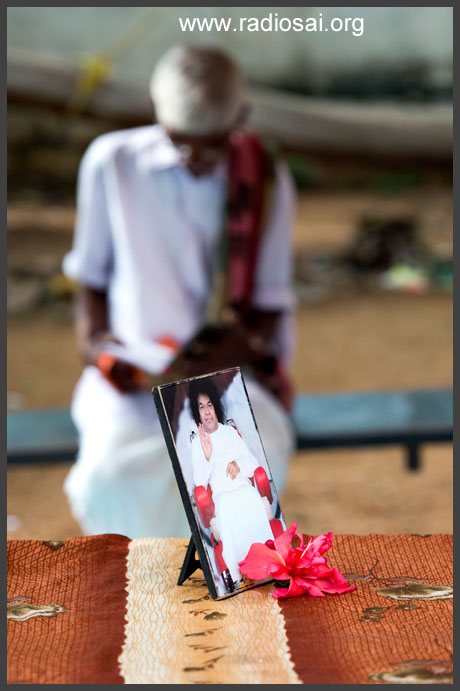 |
|
Photo Courtesy: Tim & Trev |
KM: You can’t compare apples with oranges. On one side we have an organisation that has Swami’s motivation, His spectacular vision and His selfless love as the guiding force, but on the other is a small group of men and women who have a website which displays their goal and mission.
DN: So I think that these NGOs lack somebody like Swami, may be but again the service schedule is very tough madam, I work from 7a.m. in the morning to about 8 or 9p.m. at night.
KM: How do you keep going Dr. Narasimhan?
DN: Well, when Swami Himself takes so much interest in His projects even though they are well set up and the people who have to do the jobs are doing them, still Swami always takes a lot of interest. Like when sports meet is round the corner, Swami used to come to the mandir and then go to the stadium to personally take a look at things. He had the best of architects and the best of engineers but would still go Himself (during constructions). Once Swami went to the book store and asked one of the workers, “How many books are there in this section?” So this person said “Swami, I do the accounts work.” To which Swami said, “If you do accounts work does it mean you should not know how many books are there?” So I try to follow the same example and try to be the co-ordinator or central person in this project, I take it as my sadhana (spiritual discipline). I try to have knowledge of the minutest of things, like how many tents we have, how many chairs we have, and all. And knowing all of this actually brings to you a lot of respect from the group, especially paramedics. Some even say that, “When Narasimhan has sacrificed so much, and he works so hard, so why shouldn’t we add our bit to it as well.” Of course the Director of all this is our Supreme Lord. No words can be used to express our gratitude to Him.
KM: Dr. Narasimhan, while your dedication is admirable, I understand you have personal health issues, you suffer from migraine…
DN: I’ve been getting them of late, yes.
KM: But does it come in the way of your work?
DN: No.
KM: You just take your medication and keep going?
DN: Keep going!
KM: Don’t you ever feel sorry for yourself? Don’t you just want to take a day off and sleep in?
DN: No, no, that becomes more of sickness for me. I can’t be like that; in fact right now after the interview I will be going back to the village. I will not be taking time off.
KM: That is incredible!! Now if Bhagawan were here in His physical form, what would you tell Him about the recent development?
DN: Ah yes! I would submit it all at His lotus feet and say, “Swami, the ideology which You taught us, in so many subtle ways, has been put into action and the award has been for that.” It is not the quantum of work which we have done, like the lakhs of patients we see or the scans we have done but it is the basic guiding theme of curative drive, preventive focus and spiritual base which have taken us through. Once I showed Swami five different (naam japa) books, one was written by a man who had paralysis on one side, one was written by a child, one a Muslim who had written ‘Allah Malik Sai Ram Krupa’ and one was written by a teacher... Swami was very happy to see those books. I am sure that Swami would be really happy to know about all this.
KM: By the way how many patients have we seen since this started?
 |
For the world these might be doctors about to treat patients, but in reality they are devotees of Sai performing Sadhana to please Him Photo Courtesy: Tim & Trev |
DN: We attend to about 700 patients a day, which means it would be about 8400 a month. So we must have seen around six or seven lakh patients since the year 2006.
We also have another adjunct service; the Easwaramma trust sends patients who require an ultra sound scan or a special blood test or a consultation and we perform those for them.
Medicine When Offered with Love Becomes Medicare
KM: What’s next for the Sri Sathya Sai Mobile Hospital?
DN: I always tell my paramedics, there is the one field where perhaps we all are lacking. Bhagawan wanted us to perform our service to the patients with a lot of love, and to tell you the truth, I am not totally satisfied with our work on this aspect, and that we need to improve on this front. Of course on the technical front we would like to further diversify our activities. As I told you we started with simple general surgeries, then we have started doing cancer surgeries and now we have started with laparoscopic surgeries. We want to improve the depth of the service not just the width. When I told Swami that we were doing service for 12 days, and asked for permission to further expand it, Swami said no. Of course Swami had a different reason at that time; He said, “pillalu, pellilu, chaduvulu”, meaning, “You have children, their marriages have to be done, their studies too, you should not…” then I told Him “Swami, I am always immersed in this” to which He again said “no, no”, I was surprised then, Swami said again “pillalu, pellilu, chaduvulu!”
KM: Meaning you need to see your children get through their education and marriages.
DN: He is so compassionate. For Him it’s not just about His project, He gives everything its due importance.
KM: Wow! It’s really wonderful to hear you resonate Swami’s divine vision and articulate it so well, and also translate that vision into real action pieces. So fantastic! Congratulations for your dynamism Dr. Narasimhan. It’s phenomenal and so much learning for me. I’m sure our listeners have benefitted tremendously from this.
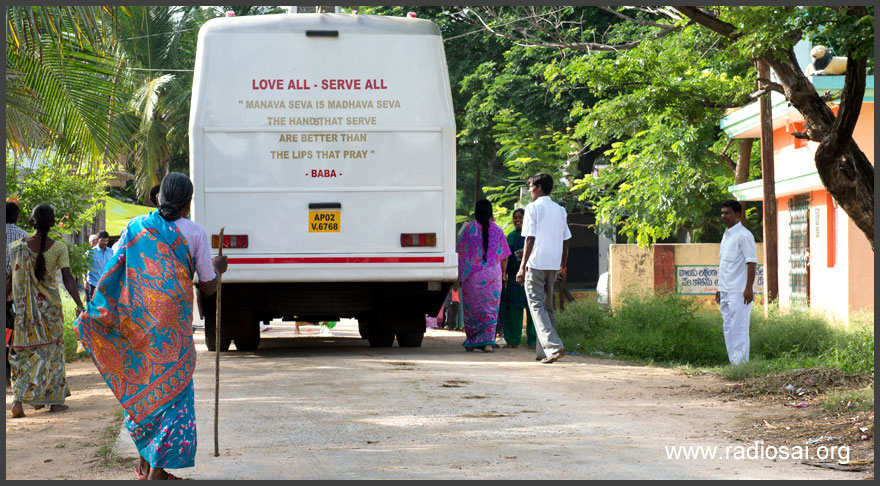 |
Photo Courtesy: Tim & Trev |
DN: I would like to wind this up with what Swami taught us. He said that it shouldn’t just be about medicine but it should be about medicare. Medicare is when you treat the patients with love and if you don’t do that, He said you are committing a sin – Medi-sin. Medicine not practiced with care is a sin. Also, He said, “Don’t be after Me all the time asking how things should be done. I will give you broad guidelines, I have given you three senses - Common sense at the mind level, Intelligence at the intellect level and Conscience at the soul level. Use these three senses and you will definitely get advice. You should see to that the art of healing is converted into Medicare, and not Medi-sin.”
KM: That’s amazing! It’s funny how a lot of big Indian cities and towns have nursing homes named Medicare, only if they knew that profit and medicare don’t go together and that Medicine is a sin when provided without love and care. We have so much to learn from your example, Dr Narasimhan. Thank you very much!
DN: Thanks for having me, madam. Sai Ram!!
You may also want to read our earlier cover story 'A Moving Marvel of Holistic Healthcare.'
- Team Radio Sai
What do you think about this article? Please let us know by writing in to h2h@radiosai.org. Do not forget to mention your name and country.







